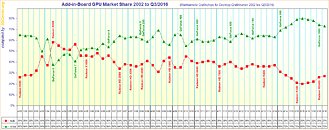Wednesday, November 23rd 2016
AMD and NVIDIA Add-in-Board GPU Market Share from 2002 to Q3/2016
The folks over at 3dcenter.org have compiled comprehensive historical GPU AIB market share data for our digestion. While we recently reported on Q3'16 and its comparison to the quarter before and the same period last year, this information spans a near 14 year quarter-on-quarter time frame. The compilers have quite helpfully included points of reference along the timeline which highlight the two major GPU manufacturers milestone desktop product line debuts.
It is worth noting that their exact numbers differ slightly to the ones Jon Peddie Research provided as 3dcenter have also cited the work of Mercury Research, which appears more conservative. The figures provided in their own graph split the difference between the two sources to give us a more impartial look at the market.Back in 2002, the two GPU manufacturers were in the earlier stages of their rivalry to dominate the desktop graphics card market. A typical PC powered by either would have utilized an "ATI" (Before their purchase by AMD in 06') Radeon 8/9000 Series or GeForce 2 MX/Ti series graphics card. The average amount of on-board video memory was 64 or 128MB accompanied by 2, 4 or if you were lucky, 8 pixel shader units. The most popular screen resolution was 1024x768, and probably on a CRT monitor. Leading API's at the time were DirectX 8.1 and OpenGL 1.3.
Fast forward to anno 2016 and some 10-15 generations of GPU later, your average on-board video memory is closer to 4 or 8GB, and now far more complex clusters of computational units that have superseded shaders number in the thousands. A typical gamers screen resolution is 1920x1080 or in many cases, beyond - not to mention the advent of VR. Both major API's are evolving too, now aiming to have much more efficient low level hardware access and less resource overhead with Microsoft's DirectX 12 and the Successor to OpenGL 4.5, Vulkan.
It is worth noting that their exact numbers differ slightly to the ones Jon Peddie Research provided as 3dcenter have also cited the work of Mercury Research, which appears more conservative. The figures provided in their own graph split the difference between the two sources to give us a more impartial look at the market.Back in 2002, the two GPU manufacturers were in the earlier stages of their rivalry to dominate the desktop graphics card market. A typical PC powered by either would have utilized an "ATI" (Before their purchase by AMD in 06') Radeon 8/9000 Series or GeForce 2 MX/Ti series graphics card. The average amount of on-board video memory was 64 or 128MB accompanied by 2, 4 or if you were lucky, 8 pixel shader units. The most popular screen resolution was 1024x768, and probably on a CRT monitor. Leading API's at the time were DirectX 8.1 and OpenGL 1.3.
Fast forward to anno 2016 and some 10-15 generations of GPU later, your average on-board video memory is closer to 4 or 8GB, and now far more complex clusters of computational units that have superseded shaders number in the thousands. A typical gamers screen resolution is 1920x1080 or in many cases, beyond - not to mention the advent of VR. Both major API's are evolving too, now aiming to have much more efficient low level hardware access and less resource overhead with Microsoft's DirectX 12 and the Successor to OpenGL 4.5, Vulkan.

45 Comments on AMD and NVIDIA Add-in-Board GPU Market Share from 2002 to Q3/2016
>Marketing
It takes a midget far more efforts as well as consistency to overcome a giant.
Hell, people even insist they have better drivers AFTER 3 incidents of them killing cards.
Just look at those charts from the past 2 years. 80% nVidia ??? Holly molly macaroni.
So I wouldn't say people were hypnotized, people try to switch sides all the time and they change their minds (or not) for whatever reason.
9000 series
and then the GTS 250.
400 series/500 series
600 series/700 series
My favorite example
GT 730. Three different models, with different buses, different memories, different GPUs under the same name with NO identification for someone who doesn't know about GPUs. That's the DEFINITION OF KINDER SURPRISE.
Definitely I can say that the current market share status is 100% sharp AMD's fault. ENTIRELY!
Nvidia 400, 500 - Fermi.
Nvidia 600, 700 - Kepler (with the 750Ti Maxwell starring as the red headed step-child)
Nvidia 900 - Maxwell
Nvidia 1000 - Pascal
Let's take a look at the red camp now
AMD HD7000 - GCN 1.0 & 1.1
AMD Rx200 - GCN 1.0, 1.1 & 1.2
AMD Rx300 - GCN 1.0, 1.1 & 1.2
So really, you can look at this any way you want. Imho, Nvidia at least looks like it's mimicking intel's tick-tock and AMD is worse, because unless you're buying the most expensive parts it pretty much guarantees you're getting an older design/process.
*I've only included retail desktop parts, because OEM and laptop parts are a mess in both camps.
8800GTS
9600GTX
GTS250
That is as bad as AMD have been, yet because of the Nvidia marketing it started the Ati/AMD decline.
Five different cards officially marketed by Nvidia using the same chip.
And if that wasn't comical enough, Chinese vendors took it to the next level by bringing the chip back in 2014 for their knock off GTX780 cards XD
Im using one of these GPU-s as my keychain (just the silicon - not the entire card).
Anyway I stop here before a certain moderator starts getting worried.